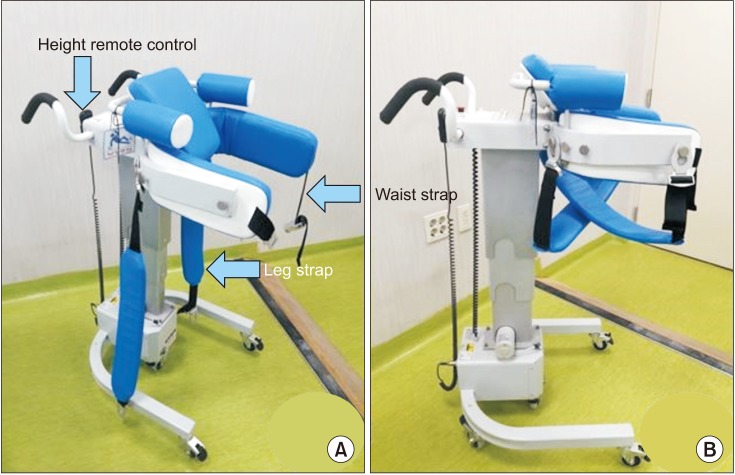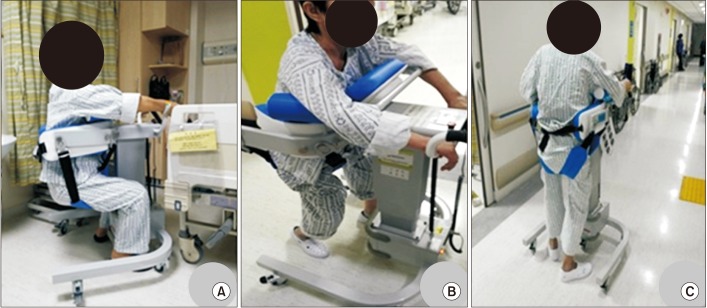Ann Rehabil Med.
2018 Apr;42(2):195-203. 10.5535/arm.2018.42.2.195.
Effect of Caregiver Driven Robot-Assisted In-Ward Training in Subacute Stroke Patients: A Case Series
- Affiliations
-
- 1Department of Physical Medicine and Rehabilitation and Regional Cardiocerebrovascular Center, Dong-A University College of Medicine, Busan, Korea. exception7@naver.com
- KMID: 2432189
- DOI: http://doi.org/10.5535/arm.2018.42.2.195
Abstract
OBJECTIVE
To evaluate the effect of caregiver driven robot-assisted in-ward training in subacute stroke patients.
METHODS
A retrospective evaluation was performed for patients treated with caregiver driven robot-assisted in-ward training to retain gait function from June 2014 and December 2016. All patients received more than 2 weeks of caregiver driven robot-assisted in-ward training after undergoing conventional programs. The robot was used as a sitting device, a standing frame, or a high-walker depending on functional status of the patient. Patients were evaluated before and after robot training. Patient records were assessed by Korean version of Modified Barthel Index (K-MBI), Functional Independence Measure (FIM), and Functional Ambulation Category (FAC).
RESULTS
Initially, patients used the robot as a sitting device (n=6), a standing frame (n=7), or a partial body-weight support high-walker (n=2). As patient functions were improved, usage level of the robot was changed to the next level. At the end of the treatment, the robot was used as a sitting device (n=1), a standing frame (n=6), or high-walker (n=8). Scores of K-MBI (Δ17.47±10.72) and FIM (Δ19.80±12.34) were improved in all patients.
CONCLUSION
Patients' usage level of the robot and functional scores were improved. Therefore, performing additional caregiver driven robot-assisted in-ward training is feasible and beneficial for subacute stroke patients.
Keyword
Figure
Reference
-
1. Belagaje SR. Stroke rehabilitation. Continuum (Minneap Minn). 2017; 23(1, Cerebrovascular Disease):238–253. PMID: 28157752.
Article2. Kwakkel G, van Peppen R, Wagenaar RC, Wood Dauphinee S, Richards C, Ashburn A, et al. Effects of augmented exercise therapy time after stroke: a meta-analysis. Stroke. 2004; 35:2529–2539. PMID: 15472114.3. Teasell RW, Kalra L. What's new in stroke rehabilitation. Stroke. 2004; 35:383–385. PMID: 14757887.
Article4. Bhogal SK, Teasell R, Speechley M. Intensity of aphasia therapy, impact on recovery. Stroke. 2003; 34:987–993.
Article5. Astrand A, Saxin C, Sjoholm A, Skarin M, Linden T, Stoker A, et al. Poststroke physical activity levels no higher in rehabilitation than in the acute hospital. J Stroke Cerebrovasc Dis. 2016; 25:938–945. PMID: 26851969.6. Miller EL, Murray L, Richards L, Zorowitz RD, Bakas T, Clark P, et al. Comprehensive overview of nursing and interdisciplinary rehabilitation care of the stroke patient: a scientific statement from the American Heart Association. Stroke. 2010; 41:2402–2448. PMID: 20813995.7. Vloothuis JD, Mulder M, Veerbeek JM, Konijnenbelt M, Visser-Meily JM, Ket JC, et al. Caregiver-mediated exercises for improving outcomes after stroke. Cochrane Database Syst Rev. 2016; 12:CD011058. PMID: 28002636.
Article8. Galvin R, Stokes E, Cusack T. Family-Mediated Exercises (FAME): an exploration of participant's involvement in a novel form of exercise delivery after stroke. Top Stroke Rehabil. 2014; 21:63–74. PMID: 24521841.
Article9. Gandolfi M, Geroin C, Tomelleri C, Maddalena I, Kirilova Dimitrova E, Picelli A, et al. Feasibility and safety of early lower limb robot-assisted training in sub-acute stroke patients: a pilot study. Eur J Phys Rehabil Med. 2017; 53:870–882. PMID: 28084064.
Article10. Tsunoda T, Maeshima S, Watanabe M, Nagai A, Ueno Y, Ozeki Y, et al. Rehabilitation for a patient with hemiplegia, ataxia, and cognitive dysfunction caused by pontine hemorrhage. Case Rep Neurol. 2015; 7:213–220. PMID: 26600785.
Article11. Redzuan NS, Engkasan JP, Mazlan M, Freddy Abdullah SJ. Effectiveness of a video-based therapy program at home after acute stroke: a randomized controlled trial. Arch Phys Med Rehabil. 2012; 93:2177–2183. PMID: 22789773.
Article12. van den Berg M, Crotty M Prof, Liu E, Killington M, Kwakkel G, van Wegen E. Early supported discharge by caregiver-mediated exercises and e-health support after stroke: a proof-of-concept trial. Stroke. 2016; 47:1885–1892. PMID: 27301941.13. Galvin R, Cusack T, O'Grady E, Murphy TB, Stokes E. Family-mediated exercise intervention (FAME): evaluation of a novel form of exercise delivery after stroke. Stroke. 2011; 42:681–686. PMID: 21233462.14. Kalra L, Evans A, Perez I, Melbourn A, Patel A, Knapp M, et al. Training carers of stroke patients: randomised controlled trial. BMJ. 2004; 328:1099. PMID: 15130977.
Article15. Veerbeek JM, van Wegen E, van Peppen R, van der Wees PJ, Hendriks E, Rietberg M, et al. What is the evidence for physical therapy poststroke? A systematic review and meta-analysis. PLoS One. 2014; 9:e87987. PMID: 24505342.
Article16. Dean CM, Channon EF, Hall JM. Sitting training early after stroke improves sitting ability and quality and carries over to standing up but not to walking: a randomised trial. Aust J Physiother. 2007; 53:97–102. PMID: 17535145.17. Braun T, Marks D, Thiel C, Zietz D, Zutter D, Gruneberg C. Effects of additional, dynamic supported standing practice on functional recovery in patients with sub-acute stroke: a randomized pilot and feasibility trial. Clin Rehabil. 2016; 30:374–382. PMID: 25952591.
Article18. Hesse S. Treadmill training with partial body weight support after stroke: a review. NeuroRehabilitation. 2008; 23:55–65. PMID: 18356589.
Article19. Combs-Miller SA, Kalpathi Parameswaran A, Colburn D, Ertel T, Harmeyer A, Tucker L, et al. Body weight-supported treadmill training vs. overground walking training for persons with chronic stroke: a pilot randomized controlled trial. Clin Rehabil. 2014; 28:873–884. PMID: 24519922.
Article20. Manning CD, Pomeroy VM. Effectiveness of treadmill retraining on gait of hemiparetic stroke patients. Physiotherapy. 2003; 89:337–349.
Article
- Full Text Links
- Actions
-
Cited
- CITED
-
- Close
- Share
- Similar articles
-
- A Review of Robot-Assisted Gait Training in Stroke Patients
- Effects of Robot-assisted Arm Training in Patients with Subacute Stroke
- Neuroplasticity Induced by Robot-assisted Gait Training in a Stroke Patient: A case report
- Robot-assisted Therapy in Stroke Rehabilitation
- Feasibility and Usability of a Robot-Assisted Complex Upper and Lower Limb Rehabilitation System in Patients with Stroke: A Pilot Study



